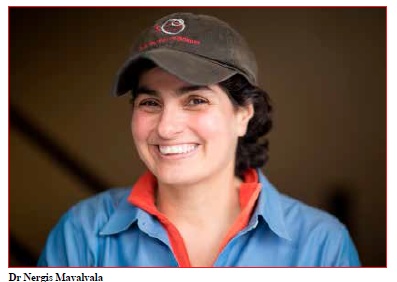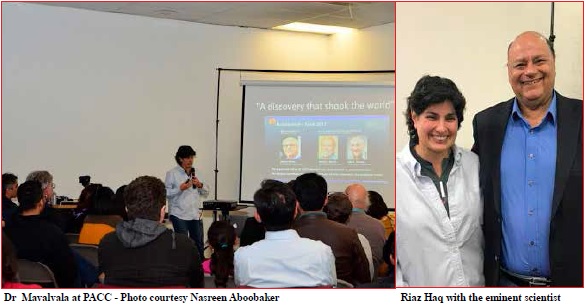Pakistan-born Astrophysicist Nergis Mavalvala Named Dean of MIT School of Science

Pakistan-born quantum astrophysicist Nergis Mavalvala has been named the new dean of the MIT School of Science, one of the five schools of the Massachusetts Institute of Technology (MIT), it emerged on Tuesday.
According to MIT News, she will become the new dean from September 1 and will succeed Michael Sipser, who will return to the faculty as the Donner Professor of Mathematics after six years of service.
Mavalvala is renowned for her pioneering work in gravitational-wave detection, which she conducted as a leading member of the Laser Interferometer Gravitational-Wave Observatory (LIGO), the report said.
"She has received numerous awards and honors for her research and teaching, and since 2015 has been the associate head of the Department of Physics. Mavalvala will be the first woman to serve as dean in the School of Science."
It added that Mavalvala was "energized and optimistic" about the role ahead, even as she acknowledged the unprecedented challenges the school and the institute as a whole were facing during this difficult time.
"We’re in this moment where enormous changes are afoot," she said. “We’re in the middle of a global pandemic and economic challenge, and we’re also in a moment, at least in US history, where the imperative for racial and social justice is really strong.
"As someone in a leadership position, that means you have opportunities to make an important and hopefully lasting impact," she said.
Meanwhile, MIT President L. Rafael Reif stated that Mavalvala's "brilliance as a researcher and educator speaks eloquently for itself".
“What excites me equally about her appointment as dean are the qualities I have seen in her as a leader: She is a deft, collaborative problem-solver, a wise and generous colleague, an incomparable mentor, and a champion for inclusive excellence.
"As we prepare for the start of this most unusual academic year, it gives me great comfort to know that the School of Science will remain in such capable hands.”
The report added that the news was announced by Provost Martin Schmidt via a letter emailed to the MIT community in which he said:
"I very much look forward to working with her and to benefiting from her unerring sense of scientific opportunity, infectious curiosity, down-to-earth manner and practical wisdom.
"I hope you will join me in congratulating her as she brings her great gifts as a leader to this new role."
Born to a Parsi family in Karachi, Mavalvala received her early education from the Convent of Jesus and Mary School, an administration official from the educational institute had confirmed to Dawn.com.
She later moved to the United States as a teenager to attend Wellesley College in Massachusetts, where she is said to have a natural gift for being comfortable in her own skin, according to an article published on the sciencemag.org website.
Mavalvala did her BA at Wellesley College in Physics and Astronomy in 1990 and a PhD in Physics in 1997 from MIT.
Before that, she was a postdoctoral associate and then a research scientist at the California Institute of Technology (Caltech), working with LIGO.
She also received the prestigious MacArthur Foundation Award in 2010. Later in 2016, Mavalvala was part of a team of scientists credited with the discovery of gravitational waves, a new window for studying the cosmos.
“We are really witnessing the opening of a new tool for doing astronomy,” Mavalvala had said in an interview at the time. “We have turned on a new sense. We have been able to see and now we will be able to hear as well.” – Dawn.com
Riaz Haq adds:
Nergis was born in Lahore and raised in Karachi before coming to the United States in 1986. She completed her PhD in Physics at Massachusetts Institute of Technology (MIT) in 1997. She did her doctoral work under Dr Rainer Weiss that included developing a prototype laser interferometer for detecting gravitational waves. Currently, she is Curtis and Kathleen Marble Professor of Astrophysics at the Massachusetts Institute of Technology (MIT), where she is also the Associate Head of the Department of Physics.

Gravitational Waves
In a brief presentation (during a visit to Silicon Valley)attended by over 100 people including boys and girls, Nergis explained Albert Einstein's gravitational wave theory and described her work in confirming the theory by detecting gravitational waves in Laser Interferometer Gravitational-Wave Observatory (LIGO) project.
Gravitational waves are the disturbances in the fabric ("curvature") of spacetime generated by accelerated stars and propagate as waves outward from their source at the speed of light. She compared the gravitational waves with the curvature and the ripples produced in a trampoline when a heavy ball is placed in the middle and bounced on it.
All Stars Die
Nergis explained that all stars, like the sun in our solar system, are born, grow and eventually die. Our sun too will die but she assured her audience that it won't happen for over a billion years. She described black holes as big stars whose light cannot escape due to their massive gravity. Huge amounts of energy are released when these massive stars collide with each other and new ones are born.
Neutron stars are created when giant stars die in supernovas and their cores collapse, with the protons and electrons essentially melting into each other to form neutrons. Given the extremely small waves of about 1,000 times smaller than a proton, the equipment required for detecting them must be extremely sensitive to tiny disturbances. LIGO equipment uses giant shock absorbers to eliminate extraneous perturbations that can alter the result.
Detected gravitational waves help scientists understand how large and how far away the colliding stars are, and allow them to recreate the moments before they collided. After such collisions, the measurements of optical light and electromagnetic waves fill in the blanks that gravitational waves can’t answer.
Origins of Gold
Answering my question about the events detected by LIGO team, Nergis said the gravitational waves generated by these neutron star collisions occurred over a billion years ago at a distance of a billion light years. From optical light and electromagnetic measurements after these collisions, scientists were able to conclude that the resulting explosion from a neutron star merger produces heavy elements like gold, platinum, and uranium. These collisions occurred well after the Big Bang that is believed to have happened about 13.7 billion years ago. Detecting events that occurred closer to the Big Bang would take much more sensitive equipment than currently available to LIGO team.
-----------------------------------------------------------------------------

